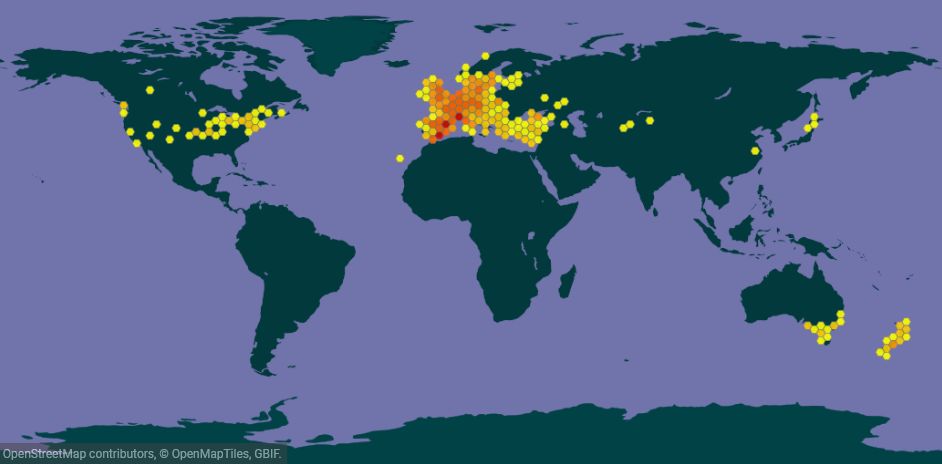 |
Black pine | Status LU: established. 1st record: LU 1823, ITW unkn. |
 |
Schwaarzkifer | Status Eur.: established. |
 |
Pin noir d’Autriche | RA: ISEIA: A2, Black List. Harmonia+: 0,25. |
 |
Schwarzkiefer | Wikipedia: |
 |
Zwarte den | Back to the list of neophytes |
Contents
Report the species
→ Report Pinus nigra to the National Museum of Natural History.
Brief description
 Pinus nigra Arnold is a wide-ranging and extremely variable evergreen conifer that usually has a straight trunk, pyramidal shape and strong horizontal branches that have upswept tips. It grows on a variety of soils, from podzolic sands to limestone.
Pinus nigra Arnold is a wide-ranging and extremely variable evergreen conifer that usually has a straight trunk, pyramidal shape and strong horizontal branches that have upswept tips. It grows on a variety of soils, from podzolic sands to limestone.
The black pine can have negative impacts on semi-dry and dry grassland biotopes.
Status and distribution in Luxembourg
Records of Pinus nigra Arnold in Luxembourg. Data source: Recorder-Lux, iNaturalist & GBIF, 2024-10-22.
Pinus nigra (syn: Pinus austriaca Höss) originated in the limestone mountains of Carinthia, Styria and Lower Austria, in Moravia, Galicia, Banat and Transylvania, and was introduced into the Schrassig Park in 1823. It is cultivated in the forest and is often confused with Pinus laricio: Neudorf (1853), Grünewald (1856), Baumbüsch ( 1863), Ernster (1867), etc. (Koltz 1875: 173).
Koltz (1873: 155) and Krombach (1875: 421) mention the species under its synonym Pinus austriaca Höss as quite common, cultivated in woods on limestone: Edingsberg, Neudorf (Koltz: 1859; Krombach: 1853), Grünenwald (1856), Baumbusch (Koltz: 1868; Krombach: 1860), etc.
Pinus nigra Arnold was next documented in Luxembourg by Léopold Reichling on 22nd May 1954 in Nommern, Municipality of Nommern (MNHNL 2000-). It remains unclear if this was cultivated or in the wild.
180 records are accessible through the MNHNL-mdata portal (MNHNL, iNaturalist & GBIF 2019).
Two subspecies are cultivated: Pinus nigra subsp. nigra (Austrian black pine) and Pinus nigra subsp. laricio Maire (Corsican pine) (Lambinon & Verloove 2012: 49). All individuals that occur in Luxembourg probably belong to the subspecies Pinus nigra subsp. nigra, Austrian black pine (Welter et al. 2008: 32).
Risk assessment
ISEIA protocol
A2 (2+3+3+3) = Black List , reassessed on 25 November 2019 by C. Ries. First assessment: A1 (2+3+3+3) = Black List (Ries et al. 2013: 18).
Harmonia+ protocol
Overall risk score 0,25 = (Overall Invasion score 0,58 x Overall Impact score 0,43) (Ries et al. 2020).
 Invasion
Invasion0,43

 Impact
Impact0,25

 Risk
RiskWorldwide distribution
Bibliography
- GBIF 2020. Pinus nigra J.F.Arnold in GBIF Secretariat (2019). GBIF Backbone Taxonomy. Checklist dataset https://doi.org/10.15468/39omei accessed via GBIF.org on 2020-03-02.
- Koltz, J.-P.-J., 1873. Prodrome de la flore du grand-duché de Luxembourg. Première partie. Plantes phanérogames. Imprimerie V. Buck, Luxembourg. 279 S.
- Koltz, J.-P.-J., 1875. Dendrologie luxembourgeoise. Catalogue des arbres, arbrisseaux et arbustes spontanés, subspontanés ou introduits dans la culture du Grand-Duché de Luxembourg. Imprimerie V. Buck, Luxembourg. 217 p.
- Krombach, J.-H.-G., 1875. Flore du grand-duché de Luxembourg. Plantes phanérogames. 564 p. Luxembourg, Imprimerie Joris.
- Lambinon J. & F. Verloove, 2012. Nouvelle flore de la Belgique, du grand-duché de Luxembourg, du Nord de la France et des régions voisines. Sixième édition. Avec la collaboration de L. Delvosalle, B. Toussaint, D. Geerinck, I. Hoste, F. Van Rossum, B. Cornier, R. Schumacker, A. Vanderpoorten et H. Vannerom. Jardin botanique national de Belgique, Meise. CXXXIX + 1195 pp. ISBN : 9789072619884.
- MNHNL, 2000-. Pinus nigra Arnold in Recorder-Lux, database on the natural heritage of the Grand Duchy of Luxembourg. Musée national d’histoire naturelle, Luxembourg. URL: https://mdata.mnhn.lu [Accessed 2019-10-14]
- MNHNL, iNaturalist & GBIF, 2019. Pinus nigra Arnold in MNHNL-mdata, online portal combining species observation from Recorder-Lux, iNaturalist and GBIF. National Museum of Natural History, Luxembourg. URL: https://mdata.mnhn.lu [Accessed 2019-10-14]
- Ries, C. & Y. Krippel, 2021. First records of 56 invasive alien vascular plants in Luxembourg. Bulletin de la Société des naturalistes luxembourgeois 123: 115-127. [PDF 241 KB]
- Ries, C., Y. Krippel & M. Pfeiffenschneider, 2020. Risk assessment after the Harmonia+ protocol of invasive alien vascular plant species in Luxembourg. Bull. Soc. Nat. luxemb. 122: 197-205. [PDF 132 KB]
- Ries, C., Y. Krippel, M. Pfeiffenschneider & S. Schneider, 2013. Environmental impact assessment and black, watch and alert list classification after the ISEIA Protocol of non-native vascular plant species in Luxembourg. Bull. Soc. Nat. luxemb. 114: 15-21. [PDF 652 KB]
- Welter A., J.Turk & J. Trossen, 2008. Les arbres introduits au Luxembourg. Inventaire des essences arborescentes non indigènes de pleine terre présentes sur le territoire du Grand-Duché de Luxembourg. Ferrantia 53, Musée national d’histoire naturelle, Luxembourg, ISSN 1682-5519, 111 pp.
Suggested citation of this webpage
Ries, C., M. Pfeiffenschneider & Y. Krippel (Eds.), 2024. Pinus nigra Arnold. In: neobiota.lu - Invasive Alien Species in Luxembourg. National Museum of Natural History, Luxembourg. URL: https://neobiota.lu/pinus-nigra/ [Accessed 2024-10-22].
Page content last updated on 2021-03-05. Last proofread by Caroline Grounds on 2019-11-20.


